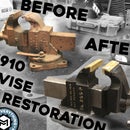Introduction: How To: Mobile Boxwood Hedges! (Artificial)
In this project I build some artificial Boxwood hedges that are easy to move and make a great backdrop or barrier for a party or event! Check out the video of the build below, or dive into this intractable for a detailed write up of the process!
Step 1: Design
The design of this “Hedge” is pretty straight forward, and can easily be adapted to your specific space requirements. In my case the hedge had to be 7’ 6” tall ( including the wheels) and 48” wide. It also had to be 12” deep.
Step 2: Gather Material
I had to make 5 of these hedges for a project so I needed quite a bit of material. Chances are your only building 1 or two so your material will be less, but here is a list of what each hedge consumed:
2.5 - sheets of 1/2 OSB plywood
6 - 2x2 Pine dimensional lumber
4 - 1 x 3 #1 Pine Board
.5 Sheet of pre primed bead board (1/4” thick”)
60 square feet of artificial Boxwood hedge ( Does not include covering the top)
4 - Locking pivot casters
2 small hinges ( For the flip up back)
1 Pair of “Hook and Eye” (for the flip up back)
Step 3: Break Down the Plywood
I like to do as much cutting outside as I can when I'm working with sheet goods. I don't have to worry about dust management and thats a big plus for me. Im using a Centipede sawhorse to hold my material and cutting on the pile. Im using a home made skills rip fence thats made out of 1/2” MDF. There are lots of great tutorials on how to make these online. If you dont have a track saw, make yourself a rip fence. you wont regret it. Usually I would clamp down my rip fence but since this material is being panted and covered in bush material I am screwing down the fence directly to the pile.
With this saw I am able to cut 2/3 pieces of plywood at a time, which helps speed up the process.
I cross cut the full sheets for the height of the hedges, and then rip 11” pieces to act as the sides. I leave these a full 8’ long and cut them down to the proper height inside on the miter saw
Step 4: Cut Down the Framing Material.
I like to use 2x2 dimensional lumber on a project like this, its light weight in comparison to a 2x4 and also more economical. Home Depot sells them in bundled packs of 9 pieces. On a project like this I cut the bundles at once, since size is not extremely critical.
I cut these down the the proper height needed for the hedges, the off cuts were used as assertional support. there was very little waste on this project.
Step 5: Assembling the Hedge "box"
Using glue and 1 5/8” screws I assemble the box. I was a finished 48” wide face so I allow the sides to be underneath that front piece of plywood during assembly. I add extra framing to the sides. top and bottom to keep them nice and rigid. Use lots of screws and always use glue!!
I used a collated drywall gun when doing work like this. This screw gun is meant to be used on drywall but I've found it works great on plywood and pine material. It saved me HOURS on this project. And over the course of the 5 boxes I made I used over 800 1 5/8” screws.
Step 6: Adding the Casters
My hedges needed to be mobile, and some-what all terrain. I didn't want to add too much height with a big wheel so I went with 3” locking casters. A tip when it comes to installing casters on anything that has a tendency to tip: The base of the caster is usually a rectangle, always make sure the LONG side of the caster base is PARALLEL to the LONG side of the object you are attaching them to. That allows the wheel to be as close to the edge as possible.
I used 1 5/8” Large head screws to attach these wheel and I'm sure to hit some of the 2x2 framing to keep them from ripping off.
Step 7: Lay Out the Planter
To give these hedges a nice finished look I will be adding a face applied “planter”. My planter will be 18” tall from the bottom of he hedge and wrap around the whole unit. I always make sure to remeasure the box before I start cutting material to double check.
Step 8: Cut Down the 1 X 3 Face Frames and Make a Sample
Ill be using #1 pine 1x3 as the trim to the planter and I cut it down using the miter saw. These will have butt joints and pocket screws. Pocket screws are prefect for this application, it gives a nice strong hold and a clean finished look on the face. Since these will be face nailed to the box its not necessary to add lots of pocket screws.
Step 9: Test Fit the Planter Face Frames
Before cutting up the rest of the material to these dimensions, you want to test fit them on the hedge box and make sure they will work universally throughout the project.
Step 10: Cut a Rabbit to Accept the Bead Board.
The bead board I'm using is 1/4” thick, so I set up a 1/4”+ thick dado stack on my table saw. I also make up a quick sacrificial fence using extra 1x3 material. I make the sacrificial fence so I can have the fence directly up against the spinning dado stack and not damage my main saw fence.
I proceed to rip every piece of face frame material to accept the 1/4” beadboard.
On the long sides that will have exposed edges I “Dive” the material into the dado stack and lift it up before reaching the end. This gives me a pocket that the headboard will sit in and doesn't take away material that would be see from the side view of the planters. NOTE: THIS IS VERY DANGEROUS AND YOU SHOULDN’T DO IT, BE SMART, USE A ROUTER.
Step 11: Cut Down the Bead Board and Add It to the Frames
I rip my 8’ pieces of beadboard down into half sheets so they are more manageable, then I set up a rip fence at around 14” and proceed to cross cut a bunch of pieces to fill my planter face frames. I then attach the pieces to the frames using glue and 5/8” 18GA staples. This will keep them in place really well.
Step 12: Assemble 3 Sides of the Planters
I chose to assemble 3 sides of the planter on the bench to make things easier for me later on. I use glue and 18ga brad nails to get everything held together nicely.
Step 13: Attach the 3 Sided Planter
I attached the 3 sides of the planter faces using 18ga brad nails. I was careful with my alignment and made sure to hit framing material with the 1 1/2" 18ga brad nails.
Step 14: Add a Hinged Back Panel and Space for Weights
Since these hedges are so tall but also narrow I wanted to give a space to add sandbags in the bottom. The best way i found to do that was to make the back of the planter hinged, and cut some holes in the back using a skill saw. I cut these “windows” to keep the frame rigid but also give a nice bit of space to get sand bags inside. The back panels are attached with two small hinges and they line up nicely with he already attached side panels.
Step 15: PAINT!
I want to say, I really hate painting but sometimes you just have no choice. I primed the planters white with a semi gloss primer, and painted the “hedge” section with a flat dark green paint. I went back and did a finish coat on the white sections and it hid any knots or scuffs on the wood. The hedge section only really needed 1 coat because of the bush material that would eventually be on top of it.
Step 16: Apply the Artificial Boxwood
This was a much more labor intensive step than I originally imagined. The boxwood panels I was given are approximately 9” x 9” and each hedge took about 80 pieces to cover 4 sides. I used an electric staple shooting 5/16” T50 Staples. The hardest part was making the boxwood look continuous and keeping my hand from cramping up from the constant BANG of the stapler. In hindsight, it would be much faster to have gotten the artificial boxwood on a long roll or large sheet. Be sure not to leave any apparent gaps!! Watch the corners!!
Step 17: Enjoy Your Everlasting Plants!
Whew! What a build! These hedges are a bit of work ( especially if your making 5 of them) but they look great when they are complete and with the proper care they will last a lifetime. They make a great backdrop or barrier and are very easy to roll with 1 person. To lift them you'll need a second set of hands! I hope you enjoyed this Instructable and learned something. Have questions? Ask them in the comments! And don't forget to check out our youtube for projects like this! http://www.youtube.com/makeeverything

Runner Up in the
Outdoor Structures













